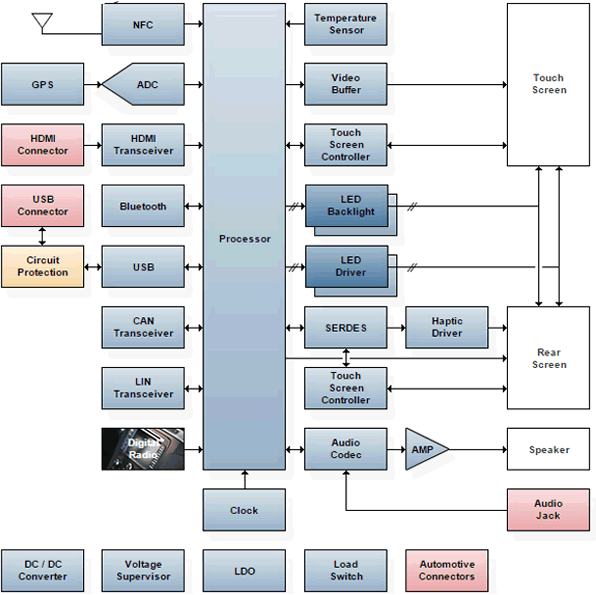Gaining Net Value to the Automotive Supply Chain
While secondary sourcing can be a viable option to mitigate supply chain interruptions, many connectors for today’s automobiles are so specialized that finding a second source can mean a whole new set of challenges.

Figure 1: Today’s connected vehicles depend on sealed and unsealed connector solutions that meet the challenge.
The “supply chain” is the process by which a company creates and distributes its products and services to the end users. The execution begins when a demand is created; the efficiency, the efficacy, and the reaction with which that company meets that demand determines its success, even when faced with global economic and industry adversity.
A Changing Supply Chain
Today’s enterprise logistics require companies to have strong business planning frameworks that support the flow of information, the flow of capital, material management, warehousing, and service. The objective is to create net value, build a competitive infrastructure, and leverage worldwide logistics, all while synchronizing supply with demand and measuring performance globally.
The science of supply chain management requires complex communication, information, and control systems. In his “C40 – City Diplomacy Addresses Climate Change” speech, Eduardo Paes, mayor of Rio de Janeiro, Brazil, said, “Globalization has produced a new level of interdependence among us. The economy and multinational supply chains do not abide by political boundaries. A computer ordered in Brazil is designed in California and assembled in several other countries. Economic integration was the first strong evidence of a new era.”
Unexpected Challenges to the Supply Chain
In today’s economy, there is no room for downtime in any part of the supply chain, no matter what the cause. Earlier this year in the US, dockworkers went on strike and bottlenecked international trade at 29 seaports from San Diego to Seattle, which handle about $1 trillion worth of cargo annually (one quarter of all US international trade, much of it with Asia). Another example is the 2.5 meters of snow that fell this winter: Trucks could not deliver and factories faced a shortage of workers who could not get to work due to the weather.
These events represent supply chain interruptions that require contingency plans that include secondary sources for both raw materials and finished goods in order to meet customers’ demands. Bottlenecks create delays and order backlogs that cause a supply chain ripple effect, which can sometimes linger long after the initial incident. The global automotive connector market is not immune to these types of interruptions.
Secondary Sourcing for Automotive
While secondary sourcing could be a viable option to mitigate supply chain interruptions, many of the connectors in today’s automobiles are so specialized, it can be difficult to find a second source. This results in a whole new set of challenges, like acceptance testing, which can be time-consuming and expensive to carry out, or assembly line delays caused by workers who are unfamiliar with a second-source connector.
For example, today’s connected car includes infotainment systems that integrate features commonly found on handheld smart devices – GPS navigation, internet connectivity, high-resolution displays, and touch controls– as well as vehicle status information such as oil pressure and battery voltage. All require automotive-grade connectors that are designed for extreme reliability to withstand the extreme temperatures, constant vibration, and tight spaces found in automotive applications. These connectors also must be smaller and lighter so the car will consume less fuel.

Automotive applications, including infotainment systems, instrumentation, HEV battery charging, braking systems, central body control, and electronic power steering HEV start/stop systems. Mouser.com
Challenges from the Global Economy
Global economic downturn and financial crises also challenge businesses’ supply chains. Reacting and adapting to the market’s demands is imperative.
Regardless of the economic conditions and global turmoil, the world continues to operate 24/7. The demand for raw materials and finished products is inexhaustible. While existing markets are flattening or drying out in some parts of the world, new ones are emerging elsewhere. The business logistics of planning, procurement, purchasing, inventory, warehousing, distribution, transportation, and customer support are still critical.
In addition to the economic and supply chain challenges faced by the automotive connector market, additional issues include:
- Demand for miniaturization and selective terminal plating due to more stringent requirements for automotive infotainment systems than for other consumer electronics
- The search for new materials that create a net value by reducing the overall weight of automotive connectors
- A rapid consumer product life cycle that quickly drives premium pricing, with only the most creative products enjoying a relatively longer period of healthy margins at the OEM level
- Automotive knockoffs and counterfeit parts, including connectors, costing a fraction (as little as 75%) of the genuine parts (With most of the counterfeit and knockoffs coming from overseas, it is a big business that costs the US economy not only billions of dollars in sales, but also thousands in American jobs.)
- Regulatory requirements that continue to expand on a global basis, both in terms of new directives, as well as the expansion of existing laws and guidelines.
According to the 2013 Roadmap from the International Electronics Manufacturing Initiative (iNEMI), the automotive electronics industry accounted for about 11% of global electronics production and reached $164 billion in 2011. After an extraordinarily strong recovery year in 2011 with more than 14% growth, the sector is still expected to experience relatively strong growth through 2017. This growth, driven mainly by strong emerging market vehicle sales, will have a positive effect on the automotive connector market as well.
With many markets still recovering from the downturn in the economy that started in 2008, the flow of goods and services is also affected. For companies, finding opportunities that bring net value to the overall supplier chain system is of vital importance if they are to remain competitive in today’s global market. Finding better ways to minimize an operation’s carbon footprint through improved distribution-center logistics; optimizing the delivery process of both raw materials and finished goods; quick response to demand spikes; and determining whether these situations are normal seasonal surges or new trends with opportunity for growth need to be understood. In addition, continued use of innovative technologies within the supply chain, capitalizing on new forms of communication such as social media, staying current with regulatory demands, and addressing the issues specific to the connector industry are all challenges that will need to be addressed to help ensure a strong supply chain within the connector market.
Note: Molex and Delphi contributed reference materials for this article.
Author Rudy Ramos is project manager for the technical content marketing team at Mouser Electronics.





